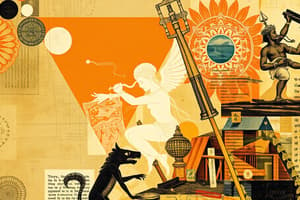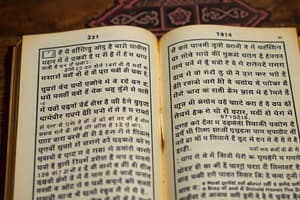Podcast
Questions and Answers
What is the oldest and most sacred Hindu scripture?
What is the oldest and most sacred Hindu scripture?
- Atharvaveda
- Rigveda (correct)
- Ramayana
- Mahabharata
The Bhagavata Purana is a major Purana.
The Bhagavata Purana is a major Purana.
True (A)
Who is the author of the Ramayana?
Who is the author of the Ramayana?
Valmiki
The _______________________ deals with rituals and sacrificial procedures.
The _______________________ deals with rituals and sacrificial procedures.
Match the Vedic literature with its description:
Match the Vedic literature with its description:
Who developed the theory of Vishishtadvaita Vedanta?
Who developed the theory of Vishishtadvaita Vedanta?
The Bhakti movement emerged in North India.
The Bhakti movement emerged in North India.
What is the story of the Ramayana?
What is the story of the Ramayana?
The _______________________ is the story of the Pandavas and Kauravas.
The _______________________ is the story of the Pandavas and Kauravas.
What is the Bhakti movement?
What is the Bhakti movement?
Flashcards are hidden until you start studying
Study Notes
Vedic Literature
- Rigveda: Oldest and most sacred Hindu scripture, composed around 1500 BCE
- Collection of 1,028 suktas (hymns) praising gods and goddesses
- Describes the early Vedic period and the Aryan invasion of India
- Yajurveda: Deals with rituals and sacrificial procedures
- Samaveda: Focuses on melodies and chants
- Atharvaveda: Contains spells, incantations, and prayers for protection and healing
- Upanishads: Philosophical texts discussing the nature of ultimate reality (Brahman) and the self (Atman)
Epics and Puranas
- Ramayana: Oldest epic poem, attributed to Valmiki (500 BCE)
- Story of Rama, a prince of Ayodhya, and his battle against Ravana, the king of Lanka
- Teaches duty, loyalty, and the triumph of good over evil
- Mahabharata: Longer and more complex epic, attributed to Vyasa (400 BCE)
- Story of the Pandavas and Kauravas, two groups of cousins, and their battle for the throne of Hastinapura
- Explores themes of duty, family, and the struggle between good and evil
- Puranas: Ancient texts that narrate the creation of the universe, mythology, and genealogies of gods and goddesses
- 18 major Puranas, including the Bhagavata Purana and the Vishnu Purana
Bhakti Movement
- Bhakti: Devotional movement emphasizing personal devotion and love for a chosen deity
- Origins: Emerged in the 7th century CE in South India, influenced by Alvars and Nayanars
- Key figures:
- Ramanuja (11th century CE): Developed the theory of Vishishtadvaita Vedanta, emphasizing the importance of devotion
- Chaitanya Mahaprabhu (15th century CE): Popularized the Bhakti movement in Bengal, emphasizing devotion to Krishna
- Influence: Shaped Indian literature, music, and art, and continues to influence Indian spirituality and culture
Vedic Literature
- Oldest and most sacred Hindu scripture is the Rigveda, composed around 1500 BCE
- Rigveda is a collection of 1,028 suktas (hymns) praising gods and goddesses, describing the early Vedic period and the Aryan invasion of India
- Yajurveda deals with rituals and sacrificial procedures
- Samaveda focuses on melodies and chants
- Atharvaveda contains spells, incantations, and prayers for protection and healing
- Upanishads are philosophical texts discussing the nature of ultimate reality (Brahman) and the self (Atman)
Epics and Puranas
- Ramayana is the oldest epic poem, attributed to Valmiki (500 BCE), telling the story of Rama, a prince of Ayodhya, and his battle against Ravana, the king of Lanka
- Ramayana teaches duty, loyalty, and the triumph of good over evil
- Mahabharata is a longer and more complex epic, attributed to Vyasa (400 BCE), telling the story of the Pandavas and Kauravas, two groups of cousins, and their battle for the throne of Hastinapura
- Mahabharata explores themes of duty, family, and the struggle between good and evil
- Puranas are ancient texts that narrate the creation of the universe, mythology, and genealogies of gods and goddesses
- There are 18 major Puranas, including the Bhagavata Purana and the Vishnu Purana
Bhakti Movement
- Bhakti is a devotional movement emphasizing personal devotion and love for a chosen deity
- Bhakti movement emerged in the 7th century CE in South India, influenced by Alvars and Nayanars
- Ramanuja (11th century CE) developed the theory of Vishishtadvaita Vedanta, emphasizing the importance of devotion
- Chaitanya Mahaprabhu (15th century CE) popularized the Bhakti movement in Bengal, emphasizing devotion to Krishna
- The Bhakti movement shaped Indian literature, music, and art, and continues to influence Indian spirituality and culture
Studying That Suits You
Use AI to generate personalized quizzes and flashcards to suit your learning preferences.




